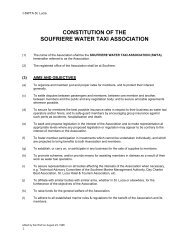WWF Cover photo - Soufriere Marine Management Association ...
WWF Cover photo - Soufriere Marine Management Association ...
WWF Cover photo - Soufriere Marine Management Association ...
Create successful ePaper yourself
Turn your PDF publications into a flip-book with our unique Google optimized e-Paper software.
Thousand Islands, St Lucie canal and at the entrance to various other rivers. They do not have concentrations ofworld-record fish associated with them. The second largest concentration of record fish was associated with theEverglades National Park. This park introduced bag limits and minimum sizes before the rest of Florida. It alsoestablished a no-take area in 1980 to protect crocodiles and all commercial fishing in the area stopped in 1985.Using underwater visual census, Faunce et al. (2002) found that grey snapper, (Lutjanus griseus) an importantrecreational fishery species, were larger in the Everglades National Park Crocodile Sanctuary than in comparableunprotected area of Florida Bay and Biscayne Bay. They found that the modal size in the crocodile sanctuarywas 25-30cm, whereas in Florida Bay and Biscayne Bay it was 15-20cm, below the minimum legal size for greysnapper in the recreational fishery, which is 25.4cm. In the crocodile sanctuary 66.2% of fish were above thelegal capture size, whereas in Florida Bay 29.6% where legal and in Biscayne Bay just 15.6% were above thelegal size. The crocodile sanctuary contains mangrove habitat and there are few such areas protected in the US,despite being an important habitat in the life cycles of many commercial fish. The use of marine reserves in themanagement of estuarine fisheries is still in its earliest stages around the world but this study providesconvincing evidence that reserves work in estuarine habitats.Another criticism levelled at the Merritt Island study is that world-record size fish are attributable to othermanagement measures introduced in Florida, including bag limits, size limits and a ban on gill nets implementedin 1995 (e.g. Tupper 2002). However, such measures cannot account for the concentration of world record fisharound the Refuge as they were applied state-wide and late in the study period. For example, the net ban wasintroduced state-wide years after catches of record-size fish began accumulating near the refuge. While suchmeasures should produce greater catches of fish, it would take many years for fish to grow large enough toproduce world-records, and such records would be expected state-wide. After the net ban 18 of 20 new recordscaught in Florida between 1996 and 1999 were from the vicinity of the Merritt Island Refuge. It is hard to thinkof more robust evidence for spillover.Key points• <strong>Marine</strong> reserves can work for game fish and benefit recreational fisheries.• <strong>Marine</strong> reserves can benefit estuarine fish that move relatively long distances throughout life.• Reserves at Merritt Island provide robust evidence for spillover, and probably also enhance reproductionand subsequent recruitment to the fishery.• Reserve benefits can continue to build for long periods, and long-lived species may respond more slowlythan short-lived animals.ReferencesAnderson, W.W. and Gehringer, J.W. (1965) Biological-statistical census of the species entering fisheries in theCape Canaveral area. U.S. Fish and Wildlife Service Special Scientific Report Series No. 514.Collins, M.R., Smith, T.I.J., Jenkins, W.E. and Denson. M.R. (2002) Small marine reserves may increaseescapement of red drum. Fisheries 27(2), 20-24.Faunce, C.H., Lorenz, J.J., Ley, J.A. and Serafy. J.E. (2002) Size structure of gray snapper (Lutjanus griseus)within a mangrove “no-take” sanctuary. Bulletin of <strong>Marine</strong> Science 70, 211-216Johnson, D.R., Funicelli, N.A. and Bohnsack, J.A. (1999) Effectiveness of an existing estuarine no-take fishsanctuary within the Kennedy Space Center, Florida. North American Journal of Fisheries <strong>Management</strong> 19, 436-453.Roberts, C.M, Bohnsack, J.A., Gell, F.R., Hawkins, J.P. and Goodridge, R. (2001) Effects of marine reserves onadjacent fisheries. Science 294, 1920-1923.Stevens, P.W. and Sulak, K.J. (2001) Egress of adult sport fish from an estuarine reserve within Merritt IslandNational Wildlife Refuge, Florida. Gulf of Mexico Science 2, 77-89.Tupper, M. (2002) <strong>Marine</strong> reserves and fisheries management. Science 295, 1233-1235Wickstrom, K. (2002) <strong>Marine</strong> reserves and fisheries management. Science 295, 1233-123588



